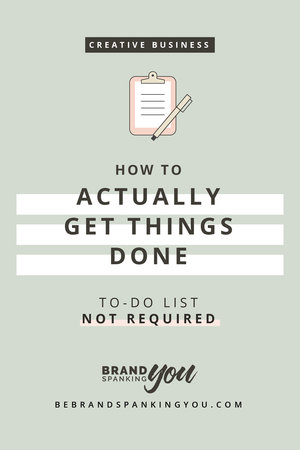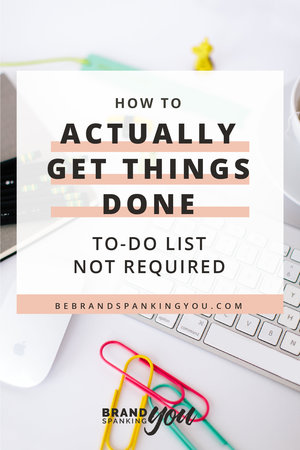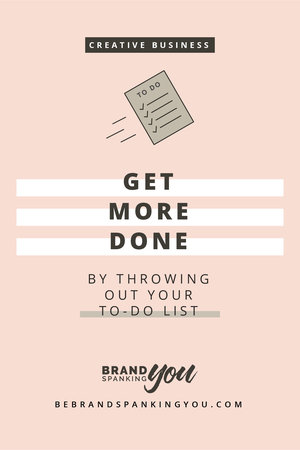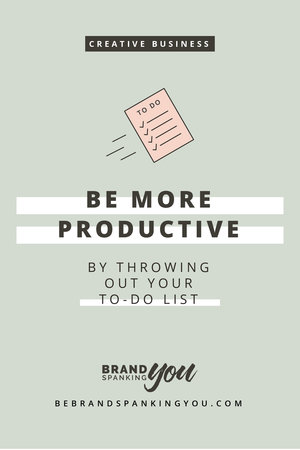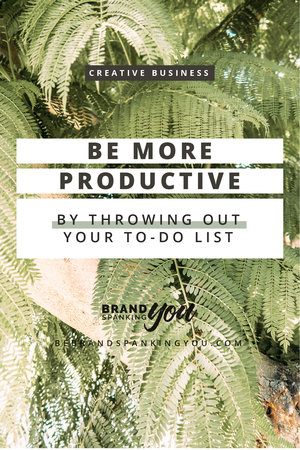Be more productive by throwing out your to-do list
As solo/ creative entrepreneurs we’re supposed to have our poop in a group, right?
Well, that is certainly NOT the case for me all the time. I’ve had my own gig going on in various forms for almost 10 years now, so you’d think I’d have this whole “getting things done/ crushing it” mindset whipped by now. I kinda pretend like that’s the case most days, but today’s the day I’m coming clean. I've lost days, weeks, and who knows how much time to endless web scrolling, social media time-sucks, and “researching” about anything you can imagine. (Including productivity and organizational tools. Head. Smack.)
I’ve tried just about every planner and productivity system out there
I’ve tried too many different planner systems to count. And I've had varying levels of success with systems like GTD, Bullet Journal, and the Productivity Planner. ALL GREAT, don't get me wrong. I start strong with them. All wide-eyed and bushy-tailed at the beginning and then about 2 weeks in (a month tops) it all goes to hell. But hey, if any of those work for you, rock on sister. I don't want to stop you being you.
Then, I discovered a dead-simple system.
I always felt a little like Goldilocks though. Nothing QUITE fit. Until I discovered Brooke Castillo’s system. I’m enrolled in her Self Coaching Scholars program, and in it, she has a whole month dedicated to getting stuff done. And no, I’m not an affiliate, I’m just a crazy fan-girl because her methods/ philosophies are life-changing.
What she teaches for getting stuff done is insanely simple- which is why it’s so easy to use. AND easy to get back on track if you happen to fall off the wagon. Which, I’m not too proud to admit I’ve done.
Ready to get more done in a week or month than you ever thought you could + have more free-time to boot?
Read on to learn about the system that makes it possible. Make sure you read all the way to the end because I’ve created a FREE bonus to help you even further.
step 1
The Brain Dump:
Grab a pen and paper and brain dump EVERYTHING you can think of that you need to do. When you think there’s nothing left, think on it some more. Get every little thing out of your head. Professional, personal- all of it. I like to create separate sections for different areas of my life, but it's not necessary. If putting it all in one big bucket works for you, rock it.
step 2
Once you have everything out, go back through the list and write out any obstacles you’ll encounter or steps you’ll need to take before doing the thing you originally listed. This is especially important if you’ve written down a big project. For instance if “redesign website” is one of your items, what are all the steps needed? Hiring a designer? Creating moodboards if you’re designing it yourself? Choosing a new platform? List all that shiz out.
I do this once a week on Sunday nights or Monday mornings. You could also do it digitally, but there’s something about pen and paper that helps my brain really shake everything loose.
step 3
Alright- now that everything is out of your brain, you’re going to transfer it all to your calendar. And I mean everything. Every single item is going to have a specific day/time assigned to it.
Now, this is where a little bit of the magic comes in. You’re going to decide ahead of time how long something is going to take and you’re going to stick to it. This is where I had the most trouble at first. In the past, I didn’t know how long things would take. I'd work until done, with no specific time-limit in mind. I've realized I was spending way too much time on things though. Not to mention getting sidetracked and pulled off in other directions too. Now I know I need to focus on the thing at hand for the specified amount of time and commit to getting it done. The end.
And speaking of committing to getting it done, you’re going to want to have a pre-determined plan in case you don’t get it done. Will you work longer that day? Finish it on the weekend? Get up early the next morning to complete it? Whatever works for you, just have a plan in place.
You’ll likely not know how much time to schedule for each task at first. I didn’t. And as the ever-optimistic person I am, I never gave myself enough time. I ran over the allotted times and felt like a frazzled, hopeless loser at the end of the day. Don’t be like me. (I mean, go ahead and be optimistic, THAT I encourage. Just stop thinking you only need 45 minutes for a 3-hour task, K?)
bonus tip:
Having said all that, here’s a tip when you’re first starting out: Think about how long you think something will take and then double it. If you’re wrong and it takes less time- congrats! You bought yourself an hour of reading magazines and sipping rose this afternoon.
Giving yourself more time vs less at the beginning is going to set you up for success in the long run. You’ll feel less stressed, and it will only take a couple of weeks to get a grasp on how long things ACTUALLY take. Listen to this interview with Brooke on Amy Porterfield’s podcast if you want to learn more about committing to specified blocks of time.
I’ve had brain dumps that are so long I’ve scheduled my calendar out 3 or 4 weeks at a time. I thought this would overwhelm me, but it has the opposite effect. Suddenly, my brain doesn’t feel like it’s forgetting things. I know that everything is right there in my calendar waiting for it’s time to come up.
As far as a calendar, use what works for you. I’m a fan of Google calendar because I like having it digital. It makes it easy for me to shift things around for meetings, or unexpected freelance projects that pop up. Plus, I have it on my phone too, which I like.
step 4
Alright, everything scheduled? now it’s time to throw out your to-do list. That’s right. Throw it away. You’re done with it because everything is on your calendar, and you’ve committed to a time to get it done. You’ll start to notice your weekly brain dumps getting smaller over time as things get scheduled. You’ll also notice you’ll start to have more free time. Seriously, it’s like magic.
Oh! Speaking of free-time, I almost forgot. You’re going to want to schedule all that into your calendar too. Yoga classes, workout times, breaks to walk the dogs, binging a couple episodes of The Great British Bakeoff; whatever free-time looks like for you, schedule it. It’s another way of reassuring your brain that there's always dedicated down-time squirreled away in your schedule.
No more long-running lists that never end.
No more transferring of tasks from one place to another because they never actually get done. No more of that “I know I’m forgetting something” feeling that nags you all day long.
It takes time to schedule things every week, but it works. Brooke compares implementing the system to riding a bike vs driving a car. You can keep peddling your bike really fast to try to keep up, or, you can slow down and get off the bike so you can jump in a car.
And as a bonus, here are a few personal additions I have to the system. If they resonate with you, go ahead and use these too. If not, never mind. Carry on.
Bonus tips
bonus tip 2
Pile Up Zone:
The pile up zone is an ongoing list that helps me with my weekly brain dumps. It’s something that I’ve adopted from David Allen’s GTD system and Todd Herman’s 90 Day Year.
I keep it in the same notebook I use for daily notes and weekly brain dumps. Throughout the week if ideas or things that I want to do, research, or look into pop into my head, I put them there. This keeps me from going down the web surfing rabbit hole when I’m actually supposed to be working on something else.
I reference this list when I do my weekly brain dump. Most, if not all get transferred unless it’s something like say, “learn Spanish”. That, I'll leave on the list as a “someday/maybe.” If too many weeks go by and it’s still on the list, I either make a conscious decision to let it go + take it off the list, or I commit to it and put it on the schedule. THIS IS AN EXCEPTION AND NOT THE RULE. If you have too many of these, your whole system will go out the window.
bonus tip 3
Pomodoro:
I have a tendency to put my head down and work away at something for hours on end. I always thought it was good to just “power through.” Studies show that taking breaks actually increases productivity though. So, I thought I’d give the Pomodoro technique a try. Well, sure enough, I was getting more done in less time + feeling less burnt out at the end of the day. Win/win!
I don’t have a set amount of time for Pomodoro sessions because certain tasks take longer or shorter durations for me. For example, doing creative work is in my zone of genius + I hate stopping if I’m in the flow. So I use longer sessions for those tasks. And for administrative work, bookkeeping, website updates etc., I use shorter 20-30 minute blocks.
I don't put Pomodoro blocks in my calendar. For instance, if I’ve scheduled 4 hours to get something done, I put 4 hours on my calendar. Then, I break that time into Pomodoro blocks as I work on it.
bonus tip 3
Trello boards:
Creating content is such a big part of my ongoing to-do list so I keep a separate trello board for it. This is stuff like blog posts, free resources, or new collections for the shop. Much like the pile up zone, if I have any ideas for content, they go here. It saves me the step of having to transfer things from one list to another all the time. Each idea becomes a “card” in Trello, and then as I work on it, I move it to active status. From there, I can add things to the card- like google docs, reference links or images.
I’ll do an in-depth post about how I use Trello for content in the future. But for THIS system, it’s helpful because my braindump list can say “write blog post” and I know ideas are waiting for me in Trello.
Now- go get more done in a month than you have in the past 3 months
And there you have it. A dead simple approach to getting more done in a month than you have in the past 3 months. While throwing out your to-do list and regaining valuable free-time every week!
And to learn more about Brooke’s approach to productivity and time management, have a listen to these podcast episodes:
The Life Coach School Episode #179: Productivity









